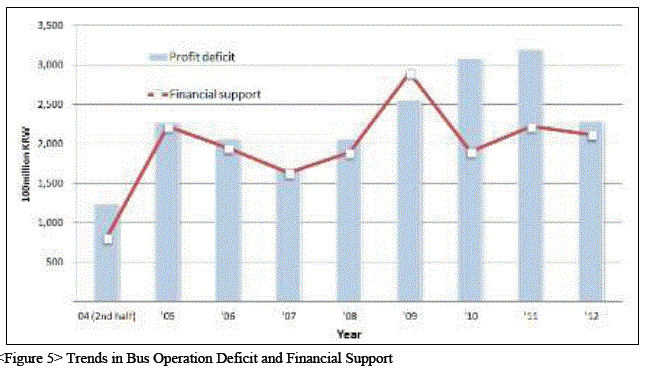إعادة تهيئة وسائل النقل العامة لسيول
It normally takes about 10 years to construct one subway line, and the costs amount to approximately KRW 130 billion per kilometer. Consequently, when discussions on the improvement of Seoul’s public transportation system began in 2002, the construction of additional subway lines was not considered a practical solution. The Seoul Metropolitan Government therefore focused on the reorganization of its bus system, while trying to enhance the convenience and efficiency of the pre-existing public transportation system including the subways.
ISSUES
1.1 Increasing Social Cost: Traffic Congestion and Environmental Pollution
By 2002 when public transportation reform began to be discussed, Seoul’s general traffic condition, despite continuous supply of infrastructure (such as road and subway construction), had continued to worsen due to the increasing number of registered vehicles and single occupancy vehicles, parking problems, and unregulated bus service. Before the reform, private cars were pointed out as a major cause of traffic congestion since they occupied 72% of the road and 79% of them had single driver. Social cost for severe traffic congestion was huge. Congestion cost reached 5 trillion won per year and energy consumption for car operation reached 4.1 trillion won.
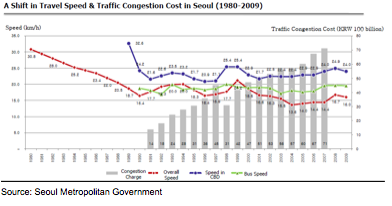
1.2 Vicious circle of bus problems
Public transportation in Seoul had many problems such as poor operating system and limited financial status. There were intertwined interests among bus companies and citizens were hesitant to make revolutionary changes. Therefore, fundamental improvement to the situation was hard to be made.
After the opening of subway system and advent of automobile era, bus passengers continuously decreased. In 2003 when the Seoul city government pushed forward the transport reform, Seoul’s city bus operation was indisputably a sunset industry, and the number of bus companies decreased to 57, compared to 103 in 1997. As a result, there was an excessive competition among bus operators to secure profitable bus routes, avoiding operations in unprofitable areas. In the process, citizen’s convenience was not considered properly. Bus service continued to deteriorate, as bus drivers often squeezed as many passengers as possible onto the bus and there were many other problems such as reckless driving, refusal of elderly or disabled passengers, and ignoring the stop request.
Due to the poor bus service, people stretched their budget to buy their own cars. In turn, automobile ownership continuously increased, which caused serious traffic congestions. Road congestion further lowered the bus service quality since bus could not arrive in time due to reduced speed. Citizens gradually became reluctant to use bus, and transport share of the bus tended to decrease year by year, dropping from 30.7% in 1996 to 26.7% in 2002. It contributed to the vicious circle since worsened bus companies’ financial difficulties led to repetitive fare increases and poorer service.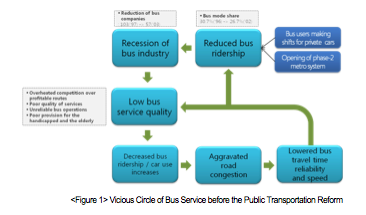
1.3 Changes in citizenship and demands for better transportation service
As the level of income and citizenship improved, people started to demand a better public service, especially in the transportation sector for the interregional mobility and accessibility. In addition, for the purpose of social inclusion and equality, implicit consensus to provide high-quality transportation service in relatively cheap price began to gain general acceptance since 2000. In specific, proper service for disadvantaged group such as the poor, disabled, elderly and young people emerged as an important issue.
1.4 Limits of gradual approach in improving public transportation
There had been attempts to renovate public transportation system in the past, but they often ended up temporary measures to solve the pending issues. In 1997, the Seoul city government pushed forward comprehensive countermeasures for the city bus system, but it was suspended due to the IMF financial crisis. By the 2000s, efforts to improve management and service through the introduction of bus route bidding and service quality evaluation system took place, but they had limited impacts. For the improvement, a radical reform was necessary.
Solution
As the new Mayor took the office in 2002, the Seoul Metropolitan Government expressed to carry out a radical reform in the public transportation system, and prepared for the detailed action plan.
2.1 Introduction of quasi-public bus system: reform of administrative management system for bus operation.
The Seoul city government’s largest concern in public transportation reform was how to change the framework of the general operating system. After contemplation, quasi-public bus system was introduced to secure the public value while maintaining the current bus operation system led by the private sector.
■ Problems of administrative management system for bus operation
Each bus route at the time was operated by a private bus company on the basis of a licensing system. Thus, the decisions to create or abolish a route were determined exclusively at the discretion of the bus companies. Privatization of bus routes made it difficult to adjust service routes, which resulted in an imbalance of service stability between profitable and unprofitable routes. In addition, lines were overlapping in profitable areas due to excessive competition among the operators, while irregularities to attract more passengers were prevalent, leading to an overall degradation of the public transportation service quality. Once licensed, routes were operated exclusively by the selected companies. The lack of competition left no incentives for them to rationalize their operations, and only to continue the old practice of lax management and inefficient operations. Moreover, the bus industry’s worsening finances had imposed gradually increasing fiscal burdens on the Seoul municipality
■ Introduction of the quasi-public bus system
The core concept of the quasi-public bus system was to transform bus routes and operational system to serve public interests. The Seoul city government secured the right to adjust bus lines, and pursued the public welfare of bus services as well as the improvement at the service level. At the same time, it introduced competition elements in some of the management system to enhance the operation efficiency.
By jointly managing revenue and redistributing it based on operational performance, bus operation and revenue management were separated. The revenue pool management system collected all the fares of bus operation, regardless of profitable or unprofitable routes, and redistributed them. In the process, bus companies whose expenses exceeded income got reimbursed for their losses, and others brought back their surplus. In other words, surplus in profitable routes was used to compensate deficits in unprofitable lines.
The quasi-public bus system comprised three major components: public management, private operation and operational infrastructure. First, public management meant that the Seoul municipality would decide and adjust bus routes to properly accommodate people’s traffic demands. Evaluation system was also established to examine operational performance, service level, and contract fulfillment. Second, private operation meant that the consortium of existing and new bus companies took control of the actual operations by settling expenses and managing vehicles, facilities and employees. The last component of operational infrastructure consists of two major elements: bus-related infrastructure such as public garages; and the city government’s financial support that supplemented the costs incurred by operating the exclusive median bus lane systems central control room, bus signal priority systems, and so forth. For this purpose, the Seoul city government established a fare settlement center and other organizations taking responsibility for managing the bus operation revenue and bus operation information and providing subsidies.
Besides, the Seoul municipality introduced competition to the industry by putting out to public tender the operation of some trunk lines and pursued customer service innovation to subsidize the bus companies for their employee benefits. Evaluations were also conducted on a regular basis to provide incentives for outstanding operators and eliminate poor services.
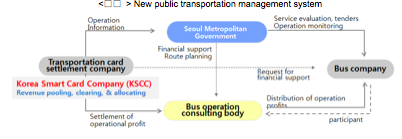
.png)
2.2 Technical reform of bus routes
■ Technical problems of the previous bus routes
The previous bus routes were often too long or circuitous, which brought about excessive traveling time and traffic congestion, decreasing the overall service quality of Seoul’s public transport. In addition, heavy overlapping of bus routes in limited areas decreased operation efficiency, while other areas were abandoned. Passengers’ service demand pattern and the intervals between buses did not match, thereby failing to meet the demand. The low speeds made the bus service even less punctual and reliable. Furthermore, the connectivity with subway stations was so inadequate that the challenge of providing a comprehensive and seamless public transportation service for citizens seemed absolutely daunting.
■ Improvement of bus routes and installation of transfer terminals
The Seoul city government divided bus routes into trunk lines for inter-regional and medium- to long-distance journeys, and feeder lines for short journeys within each region. Depending on the function, buses were divided into interregional (red), trunk (blue), feeder (green) and circular (yellow) lines. By reorganizing the bus lines, the city aimed to enhance mobility, accessibility and convenience of bus services. It also ensured to facilitate transfer between feeder, circular lines and trunk lines and focused on enhancing accessibility to meet the intra-regional demand. Reinforcing the efficiency of operations was one important consideration, too. Transfer terminals were thus installed at major junctions like Cheongnyangni to make it easy to transfer from bus to bus and from bus to subway.

■ Introduction of the exclusive median bus lane system
To raise the travel speed and service, the Seoul municipality had introduced bus-only lanes in the roadside since 1990. However, the roadside bus lane could not function properly due to illegal parking and stopping, right turn vehicles, and friction with vehicles entering and exiting the side streets. Further, various facilities installed along the sidewalks caused inconvenience since they made it difficult to recognize buses and bus stops.Median bus lanes were thus introduced via the bus reform of 2004 to improve the speed, punctuality, and operation efficiency. The sites were selected by taking into account the number of lanes, degree of overlapping with subway lines, concentration of traffic demands, inflow and outflow of traffic volume, and bus traffic volume per hour. Particularly, median bus lanes were installed where there more than three lanes in each direction were available with high traffic demand so as to connect major cities outside Seoul with centers and sub-centers of Seoul.
2.3 Reduction of public transportation fare: from ride basis to trip-distance basis
Before the reform, each public transportation means charged a flat rate per ride regardless of the traveling distance. The reform substantially lowered the average fare as it set up a system to charge passengers based on the combined distance traveled. To enable this, transfers from bus to bus and even to subways was allowed for free. As for the technical feasibility, the smart card system was introduced to analyze whether an individual passenger made a transfer or not and how long the traveling distance was. With the introduction of this distance-based charging system, the citizens were found to pay about 30% less fares for public transportation service on average. Even if a passenger travels a long distance with multiple transfers, the system was designed to charge less than the old way of charging per each ride.
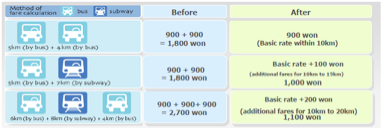
2.4 Establishment of support system for public transportation operation and improvement of facilities and vehicles
For the new public transportation system, a platform for traffic information was necessary. To integrate and process the information collected from related organizations, TOPIS (Seoul Transport Operation and Information Service) as well as BMS (Bus Management System) and BIS (Bus Information System) were established.
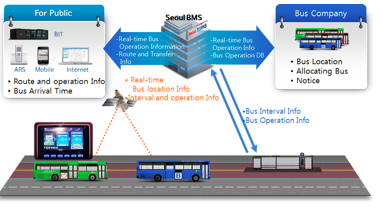
Additionally, a new transportation card system was set up to recognize whether a passenger has made a transfer and how long the travel distance was. Although a transportation card system was already out there, nearly 25 percent of passengers still opted to pay by cash as it only functioned as a means of paying fares. Hence, the new transportation card, Smart Card, was introduced with additional functions of convenience and security such as settlement service for convenience stores, parking lots and online shopping malls. Proactive efforts were also made to promote the use of the Smart Card as it was expected to bring greater transparency of management to the bus industry.
Upgrading vehicles and facilities were sought in parallel. Low-floor buses and articulating buses were introduced respectively to reinforce the services for the handicapped and vehicles’ carrying – capacity per ride.
Environmentally friendly vehicles such as CNG (Compressed Natural Gas) buses and buses equipped with DPF (Diesel Particle Filter) were also introduced to reduce pollution. Meanwhile, citizens’ safety and convenience was promoted by rearranging bus stop facilities and designating Red Zone within bus stops.
Achievements
3.1 Improvement of public transportation service
■ Citizen-oriented public transport operation
The quasi-public bus system enabled adjustment of bus routes to serve citizens’ needs, not stakeholders’ interests. In the past, bus lines were hard to adjust due to a strong opposition from bus operators who already had licenses for profitable lines. Even if the routes were adjusted, profits for bus operators often mattered, and citizens’ convenience was not a priority. After the reform, previous lengthy and circuitous routes were abolished and the hierarchical systems of trunk and feeder bus lines were established. These measures reinforced the connectivity between routes and offered more options in passengers’ choice of routes, which made bus services more convenient. Increased public welfare in bus services secured stability in bus service provisions in previously neglected areas and in turn enhanced the equity of the public transportation service. In addition, scientific route adjustment became possible through advanced smart bus management system such as BMS
■ Improved safety and comfort due to safer bus operation through the quasi-public system
Revenue pool management system enhanced bus drivers’ working conditions and relieved excessive competition among bus operators, which practically improved the service quality. Reckless driving disappeared and drivers’ attitude for passengers significantly improved. In terms of traffic safety, safe driving was enhanced, causing a sharp decline in traffic accidents.
■ Improvement in the traffic speed and punctuality
Through median bus lanes and reasonable route adjustments, the speed of buses in the peak time increased by 30% on average (10 ~ 80% depending on the section). Traffic speed increased not only in median bus lanes, but buses in regular lines also became faster. In addition, punctuality of bus service improved thanks to increased speed in the median bus lane, scientific bus management with BMS, and relieved competition among bus operators through quasi-public system.
3.2 Increase in citizen satisfaction
After the reform, citizen’s satisfaction degree for the public transport significantly increased. According to research conducted by the Seoul Development Institute in June 2005, the satisfaction rate increased from 14.2% to 36.9% after the reform. Major factors contributing to the satisfaction of consumers were ‘discounted transfer fare’ and ‘connection between subway and bus,’ while dissatisfied consumers pointed out ‘fare increase’ and ‘elimination of previous bus line.’

3.3 Increase in public transit ridership
The integration between bus and subway systems brought about increases in ridership of both. Particularly, town bus ridership surged because the integrated fare system (offering transfer discount) motivated people to use town buses, rather than walking, when approaching nearby subway stations or other bus stops. Increased ridership resulted in 10.3% revenue growth. The city saw an increase in transfer rate after the reform, particularly a sharp one in bus transfer rate. This suggests that the lower costs of transfer enabled the passengers to choose the most reasonable means of transportation.
3.4 Increase in bus drivers’ wage
Before the reform, city bus drivers’ wage level was generally lower than other workers in the similar industries. Intra-city bus drivers got paid 37% and 50% less than express bus drivers and subway drivers respectively. Such low salaries led to manpower shortages and service quality decline. Through the quasi-public system, the Seoul city government guaranteed a reasonable level of profits to the bus industry and hiked the salaries of city bus drivers. These changes are credited as enhancing the bus service quality as well as the employment stability of the drivers.
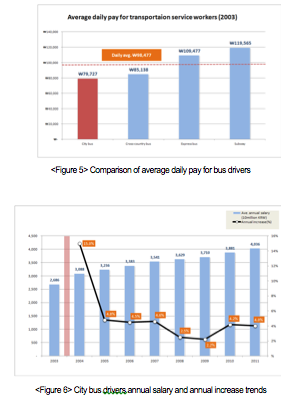
3.5 Environmental Improvement
Seoul’s PM10 was over 75㎍/㎥ in 2002, and has dropped to 44㎍/㎥) in 2013, which is lower than the Korean air quality standard (50㎍/㎥). NO₂ has also been decreasing from 0.037ppm in 2001 to 0.033ppm in 2013, yet it needs more improvement to meet the Korean air quality standard of NO₂ of 0.02ppm.
Implementation System
4.1 Establishment of task force in the City Hall
The Seoul Metropolitan Government established the “Public Transport Promotion Task Force,” composed of Seoul city officials and researchers at the Seoul Development Institute (current Seoul Institute), a think tank of Seoul, to prepare for the public transportation reform (draft). The head of the traffic management department, the highest executive in Seoul’s transportation sector, was in charge of the task force, and the collaborating research team was controlled by the “urban transport manager” of the Seoul Development Institute. Through the cooperation system, the practical alternatives of the city officials and researchers’ ideal items were appropriately combined to the public transport reform (draft).
In April 2003, when preparing for the reform draft, the Seoul city government created a post of “Transportation Policy Aide” and recruited experts from the private sector in order to promote the innovative reform. In addition, various task force teams were organized to actively address various problems that emerged during the preparation for the reform. Just before the reform implementation (July 2004), all the employees in the transportation-related departments in the Seoul municipality were involved in the preparation. After the reform was stably established to some degree, the city restructured the organizations by dividing them depending on the nature of tasks they carry out; ordinary traffic tasks and ones for complementing and expanding the reform.
* Traffic information task force(September 15, 2003): Integrated traffic information from all modes transport and road traffic conditions, and reinforced the information gathering and analysis to establish a more scientific and high-tech transport information system.
* Traffic Improvement task force(November 6, 2003): a unit dedicated to expanding exclusive median bus lanes, one of the pending issues of the reform
* Traffic improvement planning and controlling task force(August 23, 2004): made a systematic and concentrated approach to major pending issues of the reform
4.2 Bus reform citizens committee
■ Frustration in the pilot project in the northeast
In early 2003, the "public transport promotion task force” devised the blueprint of the reform, and decided to promote a trial service in northeastern Seoul (Dobong-Mia area). The region was expected to suffer from heavy traffic congestion as the Cheonggyecheon restoration project closed the overpass and two at each direction of eight lanes there were blocked, too. Therefore, it held a briefing session on the “Northeastern pilot project” with the leaders of the bus drivers’ union and the leaders of bus companies operating in the northeastern region, and announced the trial service to start from July 1, 2003
However, the plan encountered strong oppositions from bus operators, drivers and relevant organizations. The Seoul Bus Association, comprising the leaders of intra-city bus companies joined with bus drivers to hold demonstrations against the transportation reform. Further, on May 20 in 2003, the Seoul Bus Drivers’ Union came up with an opposition plan that included a bus strike in the northeastern region in the first phase and all-out strike across Seoul in the second phase. Confronting strong oppositions, the pilot project was entirely postponed.
■ The birth of the Bus Reform Citizens Committee
After the ill-fated attempt of the pilot project, rather unexpectedly, sympathetic opinions for the bus reform began to form in the civic society. With the concern rising over that there would be no solutions to Seoul’s transportation if the bus reform efforts discontinued, civic groups led the establishment of the Bus Reform Citizens Committee. They pledged their full cooperation in gathering public opinion and reaching social consensus. In response to this, the Seoul municipality and bus industry declared to join the efforts, finally resulting in the creation of the Bus Reform Citizens Committee on August 26 in 2003. Composed of four members from civic groups, eight experts and scholars, three from bus-related businesses, and five from the city council and related organizations, the committee brought together all those involved in the bus reform: bus companies, bus unions, and civic groups and played a pivotal role in coordinating conflicts among them, thereby leading to a consensus.
4.3 Transportation card system.
The previous transportation card, introduced in 1996, had revealed some problems; the limited data processing capacity, expensive commissions and maintenance costs amounting to 22.4 billion won per year. Above all, it was impossible to support the transfer between different modes of transportation (bus-subway) which would be the backbone of the city’s new transportation system. Therefore, the Seoul city government decided to make a new transportation card system to solve the problems and prepare for the new public transportation system. The plan was to attract private capital for financing the project; set up a corporation by joint funding from the city and the contractors and then distribute the revenues from the operation among the shareholders. Of the shares of the corporation, 31 percent was to be owned by the municipal government to better represent public values in devising transport policies. Through the public bidding, the LG CNS consortium was awarded the project with the condition that it should transfer a 35 percent share to the city. Accordingly, the city government and consortium founded the Korea Smart Card Co., Ltd on October 6 in 2003 and began the development of card readers to set a new transportation card system for Seoul.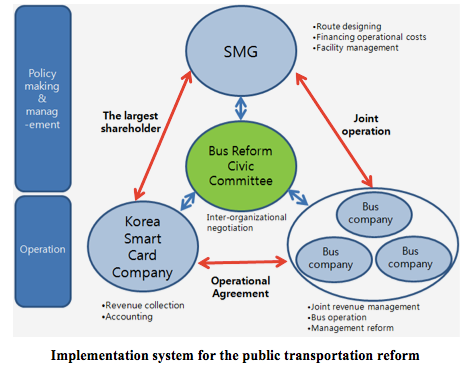
Ongoing tasks
5.1 Opposition from all the stakeholders
As mentioned earlier, the attempted trial service in northeastern Seoul fell through in the face of strong resistance from many stakeholders. However, the Seoul municipality along with the citizens committee endeavored to persuade the interested parties about the necessity of the bus reform, and embraced their opinion to supplement and improve the reform plan. Such an effort continued through the year from mid 2003, when the Seoul city government gave up the pilot project in the northeastern region of Seoul, to June 2004, when the reform was implemented.
Contention from the Stakeholders
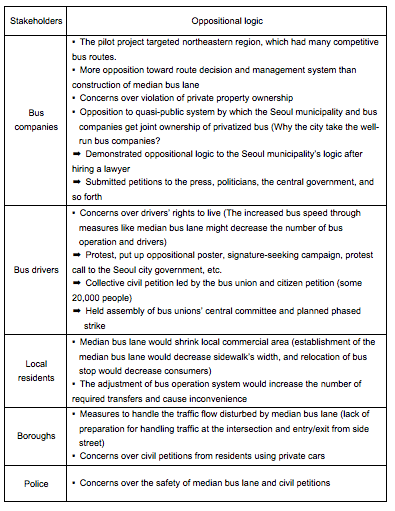
■ Bus companies
The main issue raised by the opposing bus companies was the matter of private property rights violation and more fundamentally, an issue of possible reduction in their profits. In mid-October of 2003, 22 city officials of the transportation department in the Seoul city government, 7 researchers of the Seoul Development Institute, 57 CEOs of bus companies and 9 leaders representing the bus union participated in a two-day workshop to discuss issues and exchange opinions. The workshop paved the way to build consensus for the bus reform, and detailed reform measures were discussed. Through these procedures of persuasion and adjustment, bus operators gradually began to show agreements and the Seoul city government and the bus companies signed an agreement on the collective management of fare revenue on February 4 in 2004. The agreement included implementation of tender system for 10 major corridors, institutional guarantee of reasonable profits, reasonable compensation for the surplus vehicles, measures to dispose liabilities, and guarantee of operation licenses. 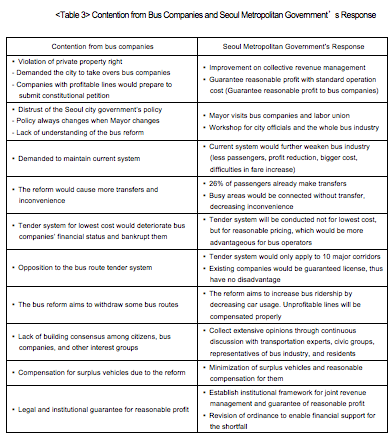
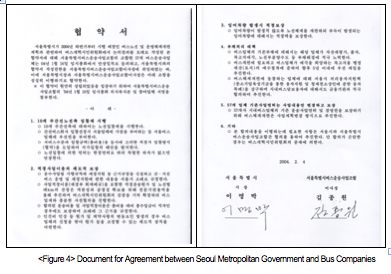
Main contents:
1. Building of a bidding system for 10 major corridors
2. Guarantee of reasonable profit
3. Compensation for surplus fleet vehicles
4. Measures for debt payment
5. Guarantee of the existing business licenses for 57 bus companies
■ Bus drivers
The main concern of bus drivers for the reform was job cuts. The Seoul municipality responded that the reform would not cut jobs, and promised to improve welfare by introducing a retirement grant system, raising wages, and expanding welfare facilities. The municipality also wrote letters to all 16,000 drivers to explain the necessity of bus reform, and offered a series of 27 special education classes for drivers from August to September of 2003 to dispel their worries about the reform. In the classes, high ranking officials including the Mayor and Vice Mayor attended to secure drivers’ trust on the city’s promise. Based on such efforts of the Seoul city government, bus drivers gradually began to come around and show agreements.
■ The Police Agency
The police agency’s major concern was the median bus lane’s safety and its impact on the traffic flow. The introduction of exclusive median bus lanes first required the consultation with (and regulatory approval from) the agency as it is responsible for traffic operation while the local government controls road construction and management. Consultation with the police agency had difficulties in the early phase, but the approval was made after a police executive participating in the bus reform citizens committee agreed to the necessity of median bus lane.
5.2 Integration of fare system with external agencies
The living zones in Seoul are not limited to the administrative boundary of Seoul Metropolitan Government, but highly integrated with other administrative areas such as Incheon and Gyeonggi-do.. Since the integration of fare system could not be decided exclusively by the Seoul Metropolitan Government, consultation with relevant administrative agencies was necessary. In particular, the project could not even begin without their agreement on whether to join the integrated fare system and on the proposed increase of the basic fare.
Raising the basic fare was unavoidable to implement the new fare system, but the Korea Railroad Corporation expressed opposition, concerned that doing so would reduce profits. After the Seoul municipality’s continuous persuasion, the Korea Railroad eventually agreed to the raise and the integrated fare system at the risk of losing money. Meanwhile, the Incheon Transit Corporation argued that the introduction of a distance-based fare system would increase burdens to long-distance passengers. Through several rounds of negotiations, basic distance and additional distance for long-distance passengers were decided to be adjusted rather than for passengers to suffer extra fare hikes.
It took even more time to secure participation by the Gyeonggi-do province and Incheon city. Finally, the integrated fare system was able to begin operation in July 2004 for Seoul and then expanded the scope in phases for Gyeonggi-do province and Incheon city respectively in July 2007 and 2009.
| ※ The implementation of Integrated Fare system: record ▪ July 1, 2007 - Trunk/Feeder/Circular/Town bus of Seoul Metropolitan Government - Local regular bus/town bus of Gyeonggi-do province - Subway of the Seoul Metropolitan Area ▪ September 20, 2008 - Inter-regional bus of Seoul Metropolitan Government - Local express bus of Gyeonggi-do province ▪ October 10, 2009 - Inter-regional/Trunk/Feeder/Express bus of Incheon Metropolitan Government |
5.3 Law revision
Amendment of legislation and new enforcement organizations were needed to implement the new systems, such as the quasi-public system, integrated fare system, new smart transportation system, and the route tender system, and to establish new facilities like median bus lanes. In response, the Seoul Metropolitan government revised previous laws, established relevant organizations, and made agreements to support the transportation reform.
■ Revision to the ‘Passenger Transport Service Act’ to calculate standard bus operation cost and to redistribute revenue through the quasi-public system
Joint revenue management was an essential prerequisite for the quasi-public system. For this, standard bus operation cost had to be settled, based on which revenue could be redistributed. The acquired operation cost would be used to determine the performance-based margin and subsidy for each bus carrier. In the beginning, the Seoul city government and the Seoul Bus Association estimated bus operation cost separately and tried to reach agreement through negotiation, which turned out to be difficult. Eventually, the subcommittee of the Bus Reform Citizens Committee determined the standard operation cost.The revenue pool management enabled bus companies to operate a stable transport service regardless of the ridership. In addition, bus companies no longer had to stick to the profitable routes.
For the system to function as intended, subsidies had to be paid to guarantee bus companies an agreed level of profits. However, the ‘Passenger Transport Service Act,’ the legal basis for bus operation in the nation, stipulated that ‘operations on unprofitable routes’ should be the only beneficiary of any financial support from the local government. Despite SMG’s request for the revision of the provision, the central government disapproved in the first place. Even though they understood the purpose of the reform, they found it difficult to allow exceptions for Seoul’s special situation. In response, the city officials persuaded the central government through persistent meetings and eventually revised the law and ordinances to make ‘bus system reform for the purpose of revitalizing the public transportation’ eligible for the financial support. Additionally, it laid out a legal foundation of the quasi-public system by enacting the ordinance on financial support for passenger transport service in Seoul and limited operation license.
■ Limited license for major trunk bus routes and tender system
The Seoul municipality intended to introduce a competition system in four profitable regions (10 major corridors and 19 routes) by tender system by enforcing a tender system in those regions. The bus operators strongly opposed the plan, but they later accepted it on the condition that it only apply to new routes and the existing operation rights be guaranteed. The carriers awarded the bids were granted temporary operation licenses for a given period.Before the reform, the license for a limited period was exclusively granted to airport buses, tourist buses and deficit-ridden bus lines. Through the revision to the ‘Passenger Transport Service Act,’ licenses for limited periods could also be provided on newly established bus routes to secure citizens’ convenience and increase transit ridership. After the revision, bids for the routes in 10 major corridors were announced and four consortiums were selected among eight bidders. The Seoul municipality and the four consortiums concluded a contract, through which a six-year operating license was granted. The agreement includes a possible extension of the contract by which existing carriers renewed their licenses for three years from July 2010.
| ※ Main contents of the agreement on the bus route tender system ▪ Examination of meeting requirements included in the tender announcement ▪ Bus operation methods and contents: Bus operating conditions (vehicles, garage, workers, opening new routes, etc.), Service level (Drivers’ attitude, vehicle cleanliness, service evaluation, etc.), Management improvement (Management system, management method, cost reduction, profit increase, etc.) ▪ Contract price (operation cost): Application of calculated standard operation cost, Determination of labor cost, gas expense and reasonable profit, Adjustment of contract price according to operating condition, management improvement and service improvement plan |
(3) Loan for bus operators
The Seoul city government prepared for the loan support system to enhance the financial status of bus companies and improve employee’s welfare. For this, “Seoul Metropolitan Government’s regulation for ordinance on establishment and management of promotion fund for small and medium business” was revised to include bus companies in the regulation’s support list.
5.4 Ongoing tasks
■Increasing operation deficit
The biggest problem with the reformed transit system in Seoul is that the subsidy to make up for the operation deficit is taking its toll on the city’s fiscal soundness. Bus operation deficits in Seoul have been on the rise, growing from KRW 270.7 billion in 2005 to KRW 488.2 billion in 2011. Behind the worsening finance was the modest fare hikes failing to offset the rising costs including labor wages. Compared to other cities in the world, Seoul’s transit fares are among the lowest. Fare increases are considered necessary by many, but the municipality has refrained from doing so for the sake of the promotion of public benefits and transit ridership. Seeking ways for deficit reduction, other than a rate hike, the Seoul municipality conducted the research on optimal number of bus in operation and guided the operators to cut back on redundant operation. It is also making other efforts such as supervision for bus operators’ lax management and re-examination on the propriety of standard operation cost.
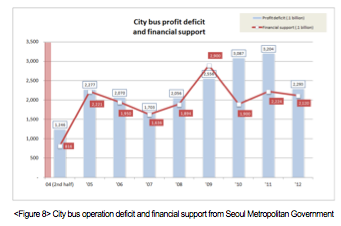
■Lack of incentives to encourage voluntary efforts from bus companies for a profitable operation
It is also pointed out that the quasi-public system has failed to motivate the operators to make voluntary efforts for cost reduction and efficiency. As of October 2010, there were 54 of 384 bus routes in Seoul that were operating in the black while the remaining 80 percent posted deficits. With all losses compensated by the municipal subsidies, the companies found no incentive for struggling with the deficits. Rather, they tended to inflate their operating costs as they are used to determine the amount of subsidy. Therefore, there is a view that the city should cut down the operations to an optimum level and provide more financial support in the form of performance-linked pay.
■ Insufficient achievement of the bus route tender system
Through the bus route tender system introduced in 2004, the Seoul municipality intended to control lax management practices of bus companies and stimulate competition among them. The metropolitan government signed a contract with the four newly established consortiums to grant them license to operate 19 trunk lines in 10 major corridors for a limited period of six years. The performance would be evaluated to decide the contract extension. However, six years after the contract signed, license of the contractors was simply extended without bidding advertisement to invite additional bidders. In the process, the municipality could not impose penalties or restrict bidding based on the evaluation of the contractors’ performance. Some criticized that such a measure privatized bus routes, although looking different from the old way, and failed to meet the original purpose; making the most of competition elements in the bus industry.
Implications
through the Bus Reform Citizens Committee, a public-private governance entity. In addition, effective planning through the cooperation between the Seoul Metropolitan Government and the Seoul Development Institute was an important factor for the success. In particular, the main direction of the reform, devised through combining practical alternatives of the city officials and researchers’ ideal items, constitutes the backbone of Seoul’s current public transportation system.
The bus reform in Seoul shows the importance of collaborative planning and communication with stakeholders in the development of transportation policy. In retrospect, the failure of trial service in northeastern Seoul was a blessing in disguise since it triggered the interests and participation of civic groups and triggered the establishment of the Bus Reform Citizens Committee. However, the failure also implies that the full-scale reform with synergy effects sometimes could be more effective than the experimental attempt for limited areas in reorganizing the public transit system.Throughout the process of the reform, the Seoul city government’s continuous efforts to persuade stakeholders and relevant organizations are noteworthy. With the infrastructures established throughout many years and complicate interests conflicting around, Seoul should and will continue its strenuous efforts to secure stronger social support and further innovate the transport system.
■ Timeline
Preparation for the public transportation reforem
- July 2002: Inauguration of the third Mayor elected by popular vote, who expressed his will for the public transportation reform
- August 2002: Establishment of ‘public transport promotion task force’ in City Hall
- October 2002: Establishment of ‘public transport reform support team,’ a research body of the Seoul Development Institute (current Seoul Institute)
Promotion of the pilot project in northeastern Seoul and its failure
- March 2003: Announcement of the pilot project (a target date of July 1, 2003)
- May 2003: Delay of the pilot project because of strong opposition from bus industry (full-scale implementation after 1 year)
Supplementing system and persuasion of stakeholders (re-preparation)
- August 2003: Birth of the Bus Reform Citizens Committee, a consultative group of bus-related stakeholders
- August 2003 ~ June 2004: Persuasion of stakeholders and system supplementation
- October 2003: Establishment of Korea Smart Card Corporation
- February 2004: Signing of the agreement on collective management of fare revenue between the Seoul municipality and the Seoul Bus Association
The public transport reform
- July 1, 2004: The implementation of the public transport reform
- July 4, 2004: Seoul Mayor issued an apology for some shortcomings of the reform
- Since August 2004: After stabilization, institutional supplement and improvement continued
FINANCING AND COST
To provide financial support for the project, private investments were encouraged to minimize the public financial burden. For example, costs for developing transportation information system (\124.9 billion) and construction of major transfer centers (\5 billion) including the ones in Yeouido and Cheongryangri were entirely sourced from the private sector.
SMG provides subsidies for bus companies to make up for their profit shortfall from quasi-public operation and free transfers. The financial aid from the city government totaled \80 billion in 2004 and \200~300 billion every year onward.
TIMELINE
Reform groundwork
-
Jul 2002: Announced the intent to reform the public transportation
-
Aug 2002: Organized Seoul Public Transportation Taskforce
-
Oct 2002: Established "Transport System Reform Support Taskforce", a research support team at Seoul Development Institute
-
Jan 2003: Conducted benchmarking studies on international transport system including U.S. and Brazil
The North-east area pilot project and failures
-
Mar 2003: Announced the Northeast Area pilot project
-
May 2003: the Northeast Area project suspended Making adjustments and reaching agreement
-
Aug 2003: inauguration of the “Bus Reform Civic Committee”
-
Aug 2003 ~ June 2004: discussion with stakeholders and accommodated their opinions
-
Oct 2003: Establishment of Korea Smart Card Corporation
-
Feb 2004: reached an agreement on joint revenue management between SMG and bus companies
Public Transport Transform
-
Jul 1 2004: launch of the reform
-
Jul 4 2004: Mayor’s release of public apology for unsatisfactory arrangements
-
Aug 2004~now: ongoing upgrades of the reform including policy revisions to stabilize the operation
LESSONS LEARNED
Without such endeavors made to reach a social consensus among stakeholders by organizations built on public-private partnership such as “Bus Reform Civic Committee”, results would have been different from what we see today. Particularly, directing policy revisions based on compromises between the city’s realistic choices and researchers’ ideal vision laid the framework for Seoul’s successful transport system. As demonstrated by Seoul’s experience, collective planning and consensus building among stakeholders is instrumental to the establishment of the new structural arrangements. In addition, experience from the early pilot operation in the Northeast region tells us that depending on the issues, a full-fledged systemic reform can turn out to be more effective as it can produce a significant synergetic effect.
CONTACT
Department / Contact
- Bus policy division / Jongyun Kim
- International Relations Division / 82-2-2133-5276 / international@seoul.go.kr
- Megacity Research Center / 82-2-2149-1418 / simrc@si.re.kr
